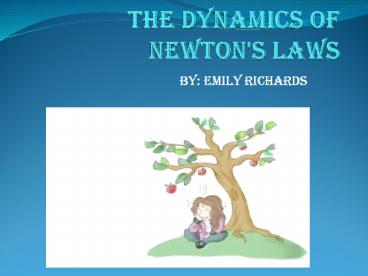the dynamics of newton's laws - PowerPoint PPT Presentation
Title:
the dynamics of newton's laws
Description:
the dynamics of newton's laws – PowerPoint PPT presentation
Number of Views:266
Title: the dynamics of newton's laws
1
The dynamics of Newton's laws
- By Emily Richards
2
Magnetic force
- Magnetic forces are produced by moving electric
charges.
3
Electric force
- Electric force is very similar to magnetic force
and gravitational force.
4
Gravitational Force
- Is were there is a atmosphere on earth that we
cant see that keeps us on earth instead off
floating into outer space.
5
Weak interaction and nuclear force
- A nuclear forces is much stronger than any other
forces, the nuclear is what holds the atom
together in spite of the stronger electric force
repulsion between in its protons. - Also these two are found inside of the nucleus.
6
Newtons first law
- Galileo guessed the time of the falling bodies
but had no why of proving the speed of the bodies
that fell. For example, Galileo formed small
angles, horizontal, the speed of the rolling
balls were slow enough to measure with a water
clock. Also Galileo proved that when the balls
spead up that they improved with time.
7
Newtons second law
- Newtons law says that the acceleration of an
object produced by net applied force is directly
related to the magnitude of the force. For
example, the effect of a 10 newton force baseball
would much greater than the same force acting on
a truck.
8
Newton's third law
- The third law is a every active force were there
is an equal and a opposite reaction. Forces are
found in pairs at most times. For example, think
of a chair by the time u sit down in a chair,
your body exerts a force downward and that chair
needs to exert and equal force upward so the
chair wont collapse.
9
FMxA
- F ma lets us work out the forces at work on
objects by multiplying the mass of the object by
the acceleration of the object. - Example The force at work on a Formula 1 car as
it starts a race! If the F1 car has a Mass of
600kg and an Acceleration of 20m/s/s then we can
work out the Force pushing the car by
multiplyingthe Mass by the Acceleration like
this 600 x 20 12000NF ma is the second law
of motion proposed by Sir Isaac Newton.
10
MF/A
- When you multiply a kilogram (mass unit) times a
meter per second squared (acceleration unit) you
get a kilogram-meter per second squared. So a
unit for force is actually the kilogram-meter per
second squared. However, no one really says that.
The unit for force is named after Isaac Newton,
and it is called the 'Newton', abbreviated 'N'.
One Newton is one kilogram-meter per second
squared. Another almost identical way to think
about the force unit is that one Newton is the
size of a force needed to accelerate a mass of
one kilogram at a rate of one meter per second
squared.
11
AF/M
- aF/m, meaning that the amount some object
accelerates is proportional to the force on it,
and inversely proportional to the object's mass
12
WMxG
- Weight has dimensions of a force. On the surface
of the earth the amount of force pushing down on
a scale is W Mg where g 9.8 m/sec is the
acceleration of an object dropped at the surface
of the earth.
13
MW/G
- 'The response of any body - with any weight (w) -
to gravity is thesame as its resistance to
acceleration' That is the ratio of anybody's
weight (w) divided by the acceleration (g) at
which it willfreefall is equal to the ratio of
the net force (f) exerted on and/orby it,
divided by the acceleration (a) that is caused.
14
GW/M
- each particle of matter attracts every other
particle with a force which is directly
proportional to the product of their masses and
inversely proportional to the square of the
distance between them. In other words, the larger
a planet's mass and the closer to a planet an
object is, the stronger the force of gravity on
that object































